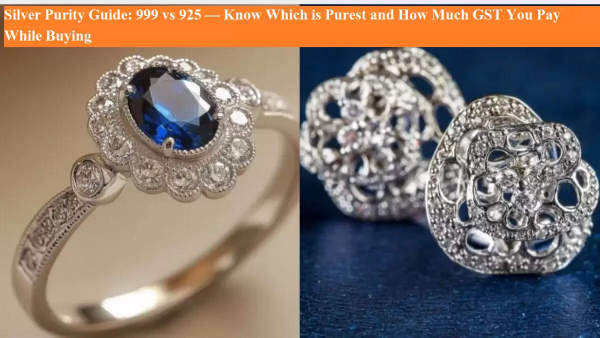
Silver Purity Explained: 999 vs 925 — Which One Is Truly the Purest and What GST Applies
With the festive season in full swing and Dhanteras just around the corner, gold and silver markets are buzzing with buyers. Purchasing precious metals during Diwali is considered auspicious in Indian tradition. This year, the government has introduced GST 2.0, also called the “Great Saving Festival”, from the very first day of Navratri. As shoppers flock to buy gold and silver, one common question is making rounds — which silver is the purest: 999 or 925? And when you buy it, how much GST do you actually pay? Let’s find out in detail.
The purity of silver is measured in parts per thousand, which indicates how many parts out of 1,000 are pure silver. According to MMTC-PAMP, one of India’s most trusted precious metal refiners, 999 silver means 99.9% pure silver, often referred to as fine silver or pure silver.
This variety contains 999 parts of silver out of 1,000, making it the highest grade of silver available in the market. Because of its extreme softness, 999 silver is mainly used for silver bars, coins, investment bullion, or premium gifting articles rather than for regular jewellery.
While it is the purest, it’s not the most practical for everyday use. Pure silver bends and scratches easily, making it unsuitable for items that require durability, such as rings, bangles, or chains. That’s why 999 silver is best suited for investors or collectors looking for long-term value rather than daily wear.
925 silver, also known as sterling silver, is the most common type used in jewellery making. It contains 92.5% pure silver and 7.5% other metals, usually copper. The addition of copper increases the metal’s strength, hardness, and durability, without affecting its shine.
This combination makes 925 silver ideal for jewellery that can withstand daily use while retaining its elegant appearance. From necklaces and earrings to bracelets and rings, most silver jewellery you buy from reputed stores is crafted in 925 sterling silver.
The hallmark “925” on jewellery pieces certifies that the metal contains genuine sterling silver — ensuring both beauty and resilience.
Whether you buy silver bars, coins, or jewellery, GST is applicable at 3% on the total purchase value. This includes 1.5% Central GST (CGST) and 1.5% State GST (SGST).
However, if you’re purchasing silver jewellery, an additional 5% GST applies on making charges, separate from the metal’s value. This rule is the same for both online and offline purchases, ensuring transparency and uniform taxation under GST 2.0.
So, when you buy a silver necklace or bangle, your final bill will include the base silver price, making charges, and the respective GST rates on both.
Silver prices have seen a sharp jump during the festive rush. According to a PTI report, the spot price of silver touched ₹1,79,000 per kilogram, marking an increase of ₹7,500 from the previous week’s ₹1,71,500 per kilogram.
The surge reflects strong festive demand combined with global market fluctuations and investor confidence in precious metals as a safe-haven asset.
When choosing between 999 and 925 silver, your purpose should guide your decision:
999 silver is ideal for investment or gifting, offering the highest purity.
925 silver is perfect for everyday jewellery, combining durability and shine.
As you head out for Dhanteras shopping this year, remember to check the purity hallmark, current silver rate, and GST details before making a purchase. A little awareness can ensure your festive investment shines as bright as your celebrations.